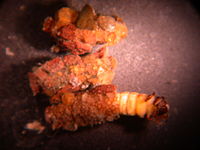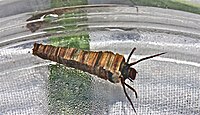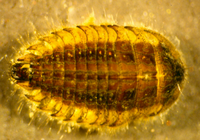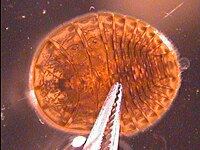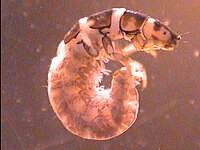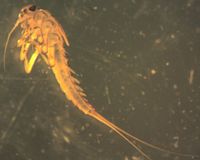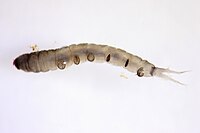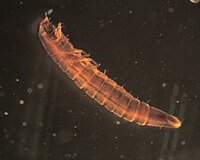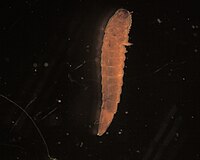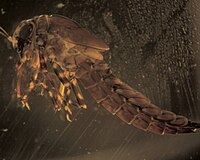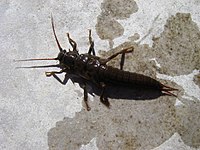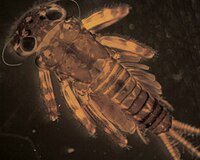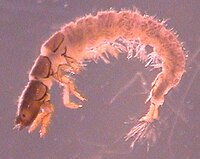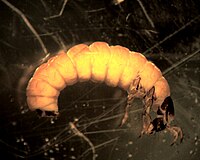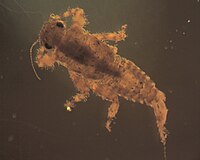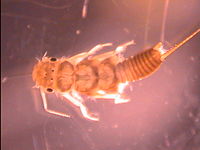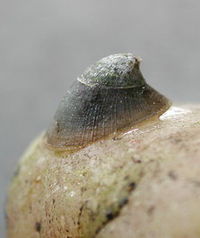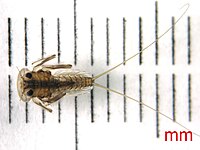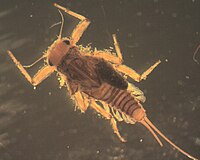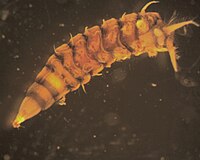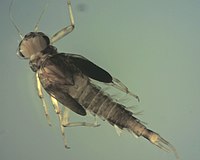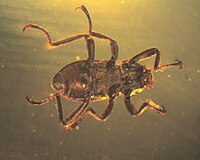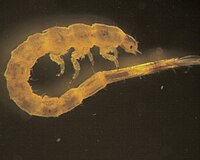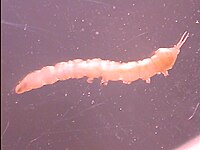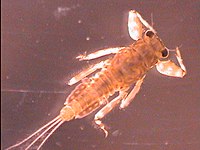Vermont EPSCoR's Streams Project; A Teacher Collaboration on WikiEducator
Openly shared content, practices, and developing resources from Vermont EPSCoR's Streams Project. Join this collaboration and make a difference!
 Lewis Creek |
|---|
|
| Basin: | Champlain |
| State or Province: | Vermont |
| Country: | USA |
| Latitude: | 44.276909 |
| Longitude: | -73.183287 |
This wiki page is for Lewis Creek by Quinlan's covered bridge on Spear Street. The following are the most common invertebrates collected from this stream site.
Chironomidae
- Order
- Diptera
- Family
- Chironomidae
- Common name
- Nonbiting midge
- Tied fly
- Griffith's Gnat
Midge larvae tend to be the most common macroinvertebrate at our sites. As with other Diptera, there are no true jointed legs. Chironomidae do have a pair of prolegs at each end and preserved individuals tend to curl into a 'C'. Identification past family requires slide-mounted heads. We have seen philopotamid caddisflies misidentified with the chironomids and we suspect that that happens when samples are being sorted from trays. Under a microscope, six prominent legs can be seen on members of the caddisfly family Philopotamidae.
More information on Philopotamidae.
Neophylax
- Order
- Trichoptera
- Family
- Uenoidae
- Genus
- Neophylax
- Common name
- Fool's Caddis
- Tied fly
- Peeping Caddis
Neophylax are characterized by having a sclerotized pronotum and mesonotum. They build a case of coarse sand grains often with a pair of latteral pebbles or "ballast stones". The larvae are rather stout and the head is scrunched in between the limbs. The anal hooks are attached directly to the abdomen and they rarely come out of the case when preserved. On the ventral surface of the abdominal segments, one can see darkened ovals, known as the chloride epithelia. Like the
Limnephilidae, they have a prosternal horn, though it can sometimes be small. Also, they have a dorsal hump and two lateral humps on the first abdominal segment- be careful! Often times, these features can be
squished down or damaged in the sampling process. A larva removed from it's case is shown
here.
The feature that distinguishes Uenoidae from Limnephilidae is the mesonotum: on either side of the midline, the anterior margin is notched.
Because our samples were taken in summer, we found large numbers of Neophylax pre-pupae. We anticipate that there will be fewer present in the streams in late September and many of those sampled will be at the pupal or adult stage. Samples taken in October would tend to have more empty cases.
Brachycentrus
- Order
- Trichoptera
- Family
- Brachycentridae
- Genus
- Brachycentrus
- Common name
- The Olive Dun Caddis
- Tied fly
- Deer Hair Caddis
These larvae are typically found with their legs extended out of their case for feeding. The cases are square in cross section and made of plant materials. Brachycentrus has 2 large sclerites on the metanotum. In fresh samples (preserved for less than one week) these organisms often have a pale green tint; live specimens are a more vivid green.
Ectopria
- Order
- Coleoptera
- Family
- Psephenidae
- Genus
- Ectopria
False water pennies are less circular than true water pennies, and come to a blunt point at the back end. They appear to have serrated edges and lack gills.
Another genus encountered in this family is Psephenus.
Psephenus
- Order
- Coleoptera
- Family
- Psephenidae
- Genus
- Psephenus
The true "water penny" is commonly found in the waters sampled.
Psephenus has a rounded shape with relatively smooth edge. The
false water penny, whose edges are serrated, has a more oval appearance. The
gills on the ventral surface are found only in the true water pennies.
Another genus encountered in this family is Ectopria.
Ceratopsyche
- Order
- Trichoptera
- Family
- Hydropsychidae
- Genus
- Ceratopsyche
Ceratopsyche has a
forked foretrochantin. The foretrochantin is the projection at the uppermost portion of the foreleg. The leg may need to be pulled away from the body to expose this feature.
Ceratopsyche have a
large pair of sclerites underneath the prosternum. Note: the large single sclerite is the prosternal plate. Biologists have gone back and forth between lumping this genus into
Hydropsyche and splitting it back out. ITIS currently lists it as a genus (Feb 2013) but we are aware of a recent paper that lumped it under
Hydropsyche.
Baetis
- Order
- Ephemeroptera
- Family
- Baetidae
- Genus
- Baetis
- Common name
- The Little Olive
- Tied fly
- Sawyer Pheasant Tail Nymph
This mayfly has three "tails" and a unique head shape. Its gills are oval shaped and insert dorsally. More mature nymphs have long, dark wing pads.
Image of the long, dark wing pads.
Antocha
- Order
- Diptera
- Family
- Tipulidae
- Genus
- Antocha
This small dipteran in the cranefly family is quite common. It is distinguished from most other dipterans we found by the 'creeping welts' that appear as prominent dark stripes along the abdomen. The dark head is usually partly exposed; however, it can be pulled back into the thoracic cavity during preservation.
Stenelmis
- Order
- Coleoptera
- Family
- Elmidae
- Genus
- Stenelmis
The larvae of
Stenelmis, as in
Ordobrevia, have a sternum on the ventral side of the pronotum. The main difference between the two genera is in the antennae the second segment is less than twice as long as the first in
Stenelmis.
The adult Stenelmis has a clear separation between the thorax and abdomen as well as a more distinctly separate head as compared to other genera.
Click here to see pictures of the sternum and
antennae-
Optioservus
- Order
- Coleoptera
- Family
- Elmidae
- Genus
- Optioservus
The larvae of
Optioservus have open coxae, as determined by the straight definition between segments on the ventral side of the pronotum.
The adult Optioservus have a compact appearance, especially the head and thorax. There are also dorsal ridges and a characteristic diamond-shaped sutellum observable in the dorsal view.
Images of the straight definition between segments, the dorsal ridgesand the diamond-shaped scutellum.
Isonychia
- Order
- Ephemeroptera
- Family
- Isonychiidae
- Genus
- Isonychia
- Common name
- The Dun Variant
- Tied fly
- Flick's Dun Variant
This mayfly has unique long hairs on its forelegs as the main distinguishing characteristic (allowing anyone keying to move through quickly). Carefully observe the limbs because such hair can be matted down and therefore hidden in preserved wet specimens. The body of
Isonychia is slim and "minnow-like" when observed dorsally. In specimens we collected, they were commonly brown and substantial in length and width as compared to the very common Baetidae.
Even when individuals are immature, closer inspection can reveal the setae on the forelegs.
Image of the long hair on its forelegs.
Pteronarcyidae
- Order
- Plecoptera
- Family
- Pteronarcyidae
Pteronarcyidae have branching gills from the bases of their legs as does
Perlidae. What distinguishes Pteronarcyidae from Perlidae is the presence of gills on the first two abdominal segments. There are only two genera in this family, but the other,
Pteronarcella, is only found in the west/southwest.
Click to see an example of Perlidae or the gills on the first two abdominal segments.
Maccaffertium
- Order
- Ephemeroptera
- Family
- Heptageniidae
- Genus
- Maccaffertium
- Common name
- The March Brown
- Tied fly
- March Brown
This genus of
Heptageniidae is distinguished by its gills on the seventh abdominal segment, which are reduced to slender filaments. Gills on segments 1-6 are truncated.
Images of the slender filaments, and the truncated gills.
Cheumatopsyche
- Order
- Trichoptera
- Family
- Hydropsychidae
- Genus
- Cheumatopsyche
Cheumatopsyche has a
forked foretrochantin (as does
Ceratopsyche). The foretrochantin is the projection at the uppermost portion of the front leg closest to the head. The leg may need to be pulled away from the body to expose this feature.
Cheumatopsyche have a small or inconspicuous
pair of sclerites under the prosternal plate that are difficult to see. Contrast that with the
larger pair of sclerites found on Ceratopsyche. To access sclerites, it's best to gently pull the pronotum and mesonotum in opposite directions. Note: the large single sclerite is the prosternal plate.
Cheumatopsyche have only 2 types of
hair on the abdomen: long thin plain hairs and thicker club hairs, which are narrow close to the body and widen out at the distal end. Paired sclerites on the ninth abdominal segment are notched.
Hydropsyche
- Order
- Trichoptera
- Family
- Hydropsychidae
- Genus
- Hydropsyche
- Common name
- spotted caddis
- Tied fly
- dark cahill
Hydropsyche are net-spinning caddisflies and share most characteristics with other members of the Hydropsychidae, including the
Ceratopsyche.
Hydropsyche are distinguished from
Ceratopsyche by the presence of scale hairs and minute spines on the three most posterior abdominal segments.
More information on the Ceratopsyche can be found here.
Image of the sclerites in the intersegmental folds.
Baetidae
- Order
- Ephemeroptera
- Family
- Baetidae
- Common name
- Small minnow mayfly
- Tied fly
- Tiny blue-winged olive
This mayfly has either two or three cerci ("tails") and a unique head shape. Its gills are oval shaped and insert dorsally. Commonly encountered genera include
Acerpenna,
Baetis and
Pseudocloeon.
More information on the genera:
Acerpenna
Baetis
Pseudocloeon
Glossosomatidae
- Order
- Trichoptera
- Family
- Glossosomatidae
- Common name
- saddlecase caddisfly
Larvae in this family build domed cases made of small rocks, and are often wider at segment 5. The pronotum is covered in dark, sclerotized plates, but there are either
no sclerites on the mesonotum, or the mesonotum is unsclerotized with the exception of a few patches. The anal proleg is broadly joined to segment 9; the anal claw has one or more accessory hooks. The
pronotal excision is small (approximately 1/3 anterolaterally) to accommodate the coxae.
Commonly encountered genera include Glossosoma and Agapetus.
Serratella
- Order
- Ephemeroptera
- Family
- Ephemerellidae
- Genus
- Serratella
Serratella's distinguishing feature is the set of paired tubercles on the dorsum of its abdomen.
Click her to view the paired tubercles.
Acroneuria
- Order
- Plecoptera
- Family
- Perlidae
- Genus
- Acroneuria
Acroneuria are among the most common Perlid stoneflies that we find. The larvae have a close-set postocular fringe consisting of thick spinules. They have three ocelli, and a yellow m-shaped mark in front of the middle ocellus. The bases of their cerci have thick, silky setae.
The postocular fringe can be seen here. Look in front of the three ocelli for the yellow m-shaped mark. Focus where the cerci meet the body to see the thick, silky setae.
Ancylidae
- Order
- Basommatophora
- Family
- Ancylidae
Members of the family Ancylidae belong in the class of Gastropoda. As Pulmonate snails, these members breathe using lung-like structures but can also use a gill-like structure called a pseudobranch to extract oxygen from water. Their shallow conical shells look like those of miniature limpets.
More information on the class of Gastropoda.
Heptageniidae
- Order
- Ephemeroptera
- Family
- Heptageniidae
- Common name
- flatheaded mayfly
- Tied fly
- Light Cahill, Wingless Pale Evening Dun
This family of mayflies can be characterized by their distinctly flattened heads and striking resemblance of the character 'Jack Skellington' from the movie 'The Nightmare Before Christmas.' This family can either have two or three cerci (tails).
Commonly encountered genera include:
Epeorus
Heptagenia
Maccaffertium
Rhithrogena
Siphlonuridae
- Order
- Ephemeroptera
- Family
- Siphlonuridae
- Genus
- Siphlonurus
- Common name
- The Gray Drake
- Tied fly
- Gold-ribbed Hare's Ear
This family has gills on all abdominal segments. The labrum does not have a deep notch, and maxillae do not have pectinate spines. They have posterolateral spines on their last abdominal segment.
Click to view the spines on the last abdominal segment, unlike those found in Baetidae.
Athericidae
- Order
- Diptera
- Family
- Athericidae
- Common name
- water snipe flies
Members of the family Athericidae have wrinkled bodies with prolegs on the ventral side. Their mandibles- which can be seen by carefully cutting the head open- move parallel to each other. On the end of their abdomen there are two lobes fringed with setae. Our collections include just the single genus Atherix.
Image of the two lobes of the abdomen.
Acerpenna
- Order
- Ephemeroptera
- Family
- Baetidae
- Genus
- Acerpenna
- Common name
- Tiny blue-winged olive
This genus is can be identified by the costal process, or projection, distal to the hind wing pad. Gill 7 is slender and may be pointed at the end. The antennal scape and pedicel have a few scattered setae (hairs).
Image of the antennal scape. A ventral view can be seen here.
Macronychus
- Order
- Coleoptera
- Family
- Elmidae
- Genus
- Macronychus
This genus can be distinguished from the others by its hind coxae: rather than being transverse, they are globular. Also, it is black and its antennae have only seven segments.
Image of the hind coxae.
Dubiraphia
- Order
- Coleoptera
- Family
- Elmidae
- Genus
- Dubiraphia
The larvae of this genus are distinguished by the last abdominal segment, which is very elongated. Adults of this genus usually have prominent longitudinal markings on their elytra and, like adult
Optioservus, have a fringe of tomentum on their anterior tibia.
Image of the fringe of tomentum.
Dicranota
- Order
- Diptera
- Family
- Tipulidae
- Genus
- dicranota
Dicranota can be distinguished by the two tails and their comb feet. There are usually 5 pairs of prolegs on the abdomen with combs on them. In addition, the posterior portion of the abdomen often has a slight swelling.
Image of the prolegs.
Ephemerella
- Order
- Ephemeroptera
- Family
- Ephemerellidae
- Genus
- Ephemerella
- Common name
- The Hendrickson; The Red Quill; The Hendrickson Spinner Fall
- Tied fly
- Hendrickson; Flick's Red Quill; Lunn's Particular
Mayflies in this genus have long intersegmental setae on their cerci that extend laterally and may or may not have whorls of spines at the end of each segment of their cerci. Their maxillary palps are well-developed.
Image of the intersegmental setae.


